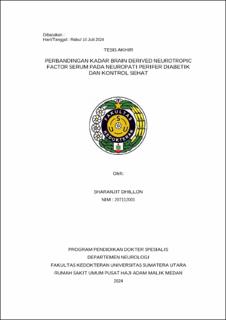| dc.description.abstract | Background: Diabetic neuropathy is a common and progressive microvascular complication of diabetes, so early detection and prevention is essential. Diabetic neuropathy is often asymptomatic in the early stages, but once symptoms and overt deficits appear, it becomes irreversible. Deficiency of the growth factor BDNF is thought to play a role in the pathogenesis of diabetic neuropathy, so that administration of BDNF is expected to improve diabetic neuropathy.
Objectives: To find out the comparison of serum levels Brain Derived Neurotropic Factor (BDNF) in symptomatic, asymptomatic diabetic peripheral neuropathy and healthy controls.
Methods: This study used a case control design. Sampling was carried out at the endocrinology polyclinic and neurology polyclinic at H. Adam Malik General Hospital, Medan. The total research sample was 42 subjects, divided into 3 groups consisting of: symptomatic diabetic neuropathy, asymptomatic, and control group, and consisting of 14 research subjects. To see the comparison of serum BDNF levels in the three groups, a test was used One Way Annova continued with Post hoc Test using the Bonferroni Test.
Results: The demographic characteristics of the symptomatic and asymptomatic diabetic neuropathy research subjects were men, while the average age group was 52,5 ± 9,25 year and 54,5 ± 9,81 years, not working, and the highest range of long history of suffering from type 2 DM, namely >=5-10 years in asymptomatic and <5 years in symptomatic. The highest mean BDNF level was found in the asymptomatic diabetic neuropathy group, namely 38.40 ± 3.23 ng/ml, while symptomatic diabetic neuropathy was 21.60 ± 2.75 ng/ml, and in controls 34.42 ± 3.24 ng/ml .
Based on test One Way Anova and After this It was found that there were differences in mean BDNF levels between the three groups, namely the symptomatic diabetic neuropathy group with asymptomatic neuropathy and healthy controls (p<0.05).
Conclusion: There is a significant difference in mean BDNF in the three research groups. | en_US |


